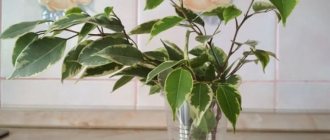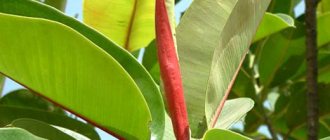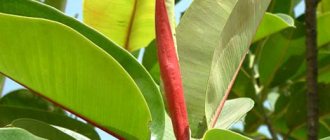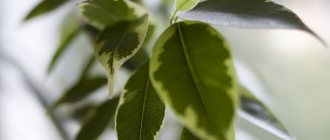Regular pruning is one of the components of caring for ficus at home. The procedure is necessary not only for beauty and increasing the density of the crown, but also to eliminate the risk of death of the entire tree in the event of individual parts being affected by disease or pests and to stimulate the growth of young shoots.
To ensure that pruning does not harm the ficus and helps achieve the desired results, it must be done correctly:
- Before the procedure, water the tree and clean it from dust;
- disinfect prepared instruments (scissors, pruning shears);
- cut shoots above the bud, thin shoots straight, thick shoots at an angle;
- first of all, remove dry, inward growing, thickened and intertwined branches;
- remove any milky juice that appears with a napkin;
- Disinfect cut areas with crushed wood ash or activated carbon.
In order to form a crown, pruning should be done in early spring, during the period of awakening and swelling of the buds.
This should not be done in the fall - in conditions of lack of lighting due to the short daylight hours, the shoots will not be able to develop evenly and the appearance of the plant will be spoiled. Pruning carried out during this period will significantly weaken the ficus - it will spend the nutrients left behind on the growth of young branches for the winter.
Expert opinion
Mokhov Andrey Petrovich
Graduated from KubSAU, specialty: agronomy
The exception is sanitary pruning - it can be done at any time of the year.
Why is pruning needed?
To keep the ficus crown fluffy, it is periodically pruned. The operation is performed according to certain rules. Pruning Ficus Benjamin at home is the main stage of caring for the plant and makes it possible to form a tree of the desired configuration.
Young plant
Features of the process are associated with the development of ficus. Its branches develop from shoots, which in turn are formed from buds. The kidneys themselves come in two types:
- Growing from the top of the trunk and ensuring the growth of the plant in height.
- Side shoots giving crown density. They are located along the entire trunk.
The rapid development of the upper buds leads to the fact that the ficus grows intensively. When they are removed, side shoots begin to grow, making it branchy and lush.
general information
Ficus benjamina has its own characteristics of growth and development. To properly perform pruning, you need to become familiar with these features.
Branches of a new order grow in this case from shoots, while shoots are formed from buds located on the main branches and trunk. Ficus Benjamin has two different types of buds:
- apical, responsible for the growth of the flower upward and located on top of the trunk;
- lateral, responsible for the growth of the crown in breadth and located along the trunk along its entire length.
The top bud has the fastest growth: if it is removed, the lateral buds begin to grow rapidly to compensate. If the goal is to get a lush crown, the top bud should be removed in the spring - when the most active growth is observed.
It is better not to model the crown in autumn and winter, since during this dormant period the crown may turn out to be one-sided and ugly. In addition, it is possible to simulate a neat crown of the desired shape only if the ficus is still young. When the plant is fully formed, it will not tolerate traumatic pruning well. Ideally, you need to complete all basic formation procedures before the ficus reaches the age of three years.
Trimming time and tool preparation
Weaving ficus benjamina at home
Spring is a time of active growth, while with the onset of cold weather the process slows down. Pruning is best done in the warmer months.
Note! Pruning in autumn or winter can lead to improper formation of the crown and deformation of the trunk.
Shaping and pruning the ficus crown is carried out when the trunk is still young and not woody. Subsequently, such interference can become fatal for the plant, and if it survives, it will take a long time to regain its strength.
For proper pruning prepare:
- pruner;
- sterile napkin;
- activated or charcoal;
- a disinfectant such as medical alcohol or a weak solution of potassium permanganate.
Before starting work, the pruning shears are disinfected so as not to infect the plant when making a cut.
Watering and humidity
Ficus loves water, so it needs to be watered frequently and abundantly. The specific frequency depends on the conditions of maintenance: air temperature, humidity, degree of illumination and age of the flower. In summer, on average, water three times a week; in winter, the amount is reduced to once a week.
Moisten the soil only when the top layer of soil is completely dry. Excess moisture negatively affects the condition of the plant, as the root system begins to rot. To prevent this from happening, the water remaining in the pan must be drained. Waterlogging is indicated by the falling of the lower leaves. For irrigation use settled soft water.
The optimal humidity level, which is ideal for maintaining Ficus Benjamin, is at seventy percent. Several methods are used to achieve this indicator. The first and most common is spraying the plant with settled water from a spray bottle. Spraying is carried out once or twice a day, wetting the leaves well. The second method is to place containers of water next to the flower, which evaporates and creates the required level of humidity.
You can purchase a humidifier that constantly maintains the desired humidity in the room. It will be useful not only for plants, but also for apartment residents, especially small children. The last, third method is to place the ficus pot on a tray filled with wet pebbles and expanded clay. It is important that the bottom of the pot does not come into contact with the filler, since the roots will begin to draw moisture from there, which will cause the soil to become waterlogged. Once a month, ficus leaves are wiped with a damp cloth to get rid of dust.
General rules for pruning Ficus Benjamin
Flower growers advise pruning Ficus Benjamin for the following purposes:
- To rejuvenate the plant. After the procedure, the trunk and branches begin to actively grow, which has a positive effect on the maturation of the ficus.
- Improvements in appearance. You can create a design for a specific room.
- Stimulating branching. If the procedure is carried out correctly, it is possible to simulate how and in what quantity the branches will grow, as well as their size in the future.
- Sanitary treatment of plants. During the growth process, dry and infected shoots are removed.
Transplanting Ficus Benjamin at home
The formation of a lush crown is achieved by pinching off a shoot growing at the very top of the trunk. It is called the growth point. It is better to do this one or two weeks before the transplant. Active growth requires a greater need for nutrients, so fertilizing is necessary.
Important! It is impossible to prune and replant the plant at the same time, as this will lead to its death. The flower will not have time to recover.
How to prune ficus benjamina? Step-by-step method for pruning Ficus Benjamin:
- Prepare the plant for the procedure, clean and water it.
- Use pre-disinfected garden tools.
- The cut on thin branches is made straight, and thick ones are shortened obliquely.
- At the end of the procedure, the instrument is disinfected by treating the sections with wood ash. Before this, remove the juice with a napkin.
- When starting to form the crown, they focus on the natural silhouette.
- Each movement of the scissors must be precise so that in the end the ficus becomes a beautiful and not a plucked flower.
- Branches that spoil the appearance of the plant are removed.
- The upper shoots and branches growing parallel to the trunk are cut off.
At home, crown formation is carried out until the flower reaches three years of age. If the plant is sick, it is better to postpone the pruning procedure for some time.
Plant pruning
Pruning to rejuvenate the plant
How to feed ficus benjamina at home
The procedure is carried out to make the tree more attractive and lush. When rejuvenating pruning, shoots that are too long and crooked are removed, as well as branches that have begun to dry out and have dropped their leaves.
Additional Information! To speed up the restoration of plants, the soil is fertilized. Old branches are removed completely, and young ones are shortened. The work is carried out during the rest period, when the ficus does not bloom.
How to rejuvenate an adult specimen?
A beautiful large tree has lost its leaves and dried up? Don't rush to throw it away. Understand the reasons for this behavior. If the reason is a long dry period or the influence of low temperatures, then the tree can be saved. It is necessary to provide him with optimal temperature conditions and good living conditions. Cut off all dried branches at the root. Or remove all the growth altogether so that young growth grows in its place. The plant will be able to recover due to its developed root system.
However, this method will not work if it is the roots that are initially damaged. And it was because of their illness that the leaves fell.
For experiments, it is better to choose a young ficus Benjamin. Forming the crown of adult specimens is more difficult. They do not grow green mass so quickly. There is no question at all about intertwining thick trunks or splicing them.
Sanitary pruning
Proper care of a flower requires not only watering and feeding it on time, but also protecting it from diseases by sanitary pruning. In this case, you can give the crown the desired shape. The procedure has the following goals: removal of dried, yellowed or infected branches and leaves; ridding the trunk of crooked and affected shoots.
The damaged part of the plant is removed to the base, this will reduce the risk of spreading the infection. If part of the root is affected, then cut it off with a piece of healthy tissue and do not forget to treat the problem area with disinfecting compounds. This will protect the flower from death.
Inspection for sanitary pruning
Formation of a beautiful crown and general appearance
Creating the desired crown shape begins with modeling the location and density of the upper and lateral shoots.
There are several crown options:
- Bush-like. Take a ficus whose age does not exceed two years, and pinch the top shoot at a height of 10-15 cm. The lateral buds that give growth are not affected. The procedure is repeated as the tree grows. With repeated manipulations, excess shoots are removed, which give unnecessary density and interfere with the normal development of other branches. To ensure uniform growth, the pot is periodically turned on the windowsill to ensure even access to sunlight.
- Crown Stamb. Its formation begins almost immediately after planting the ficus. For modeling, about five healthy buds are left on the trunk, and the rest are completely removed. When the height of the plant exceeds forty centimeters, the top is pinched. Gradually, the silhouette of a palm tree begins to form from leaves on a long and beautiful trunk. Periodically thin out the branches and turn the plant with different sides towards the light.
- Crown Tier. They are created from an already formed standard plant, in which the top is not cut off immediately, but grows another ten centimeters and only then is pinched. Side branches from the lower tier are removed completely, as well as shoots that create excessive crown density.
The beginning of bush formation
How to make a ficus standard
You will need a young ficus with a formed vertical central shoot. Trim side shoots regularly until only the top 5 branches remain. When your trunk grows to the desired height, pinch the top and constantly trim the side shoots. While the ficus is young and its trunk is not yet sufficiently woody, you need to support the plant by tying it to a support fixed in the soil.
- Photos of dizygotheca species
Try growing a multi-tiered trunk. To do this, divide the ficus crown into several parts. For example, you have 5 of them, from the first, third and fifth parts you need to form tiered crowns, and the second and fourth parts will be the spaces between these tiers - here the shoots need to be trimmed.
Root pruning
Sometimes it is recommended to remove not only the branches, but also the roots of the plant, which interfere with development. This type of work requires care and caution, as the health of the flower depends on this. Usually the root is removed when it is infected and the ficus requires replanting:
- After cleaning the soil, the roots are placed in an antiseptic solution.
- Then the injured and interfering processes are removed.
- The sections are sprinkled with activated carbon dust.
- Plant the ficus in another container.
Creating unusual shapes
There are many options for creating interesting ficus shapes. Flower growers are attracted to forms in the form of a spiral or a fence; someone may be interested in a braided braid. To do this, plant the sprouts in strict sequence. The result of painstaking work will delight you with unusual beauty if you use the right preparation scheme.
Beautiful braid
Activities after pruning
After pruning, experts recommend taking several additional actions to promote the rapid development of the plant after stress. Using a sterile napkin, remove all the milk that will be released by the sections. This must be done until the surface is completely dry. Remove the flower away from the bright sun. Water the plant strictly according to schedule, avoiding stagnation of water. Feeding is carried out, but not earlier than a few weeks after pruning.
Important! Watering is carried out with settled water at room temperature. The leaves are wiped with a damp cloth.
When pruning, watch your movements so as not to cause wounds. This can cause the ficus to become infected, weaken its strength and even destroy the flower.
Pruning ficus benjamina is not difficult, but after that you should properly care for it. It is better to choose warm months for the procedure, but if the need arises, November is suitable for this purpose. With proper pruning, you can get an interesting looking flower that will decorate your home.
Location and lighting
A resident of the southern regions, ficus benjamina, needs good lighting, because it loves soft, diffused light. It is especially necessary for variegated varieties of ficus, since the color saturation depends on the amount of sun. If the variegated variety of Ficus Benjamin stands in the shade, the variegated color will disappear and only green leaves will begin to grow. Conventional varieties develop very slowly in low light conditions.
It is advisable to place small ficus trees on the windowsills of windows facing east and west. You can place a flower near a south window, but you need to shade it and protect it from direct sunlight, which can negatively affect the condition of the leaves. Direct hot sun leaves burns on the leaf blades. A large specimen, for which there is only enough space on the floor, should be placed near a window through which the most diffused light penetrates. North-facing windows are not suitable for Ficus Benjamin.
The plant does not like changing places; it cannot even be simply turned, since such interference in the “life” of the ficus can provoke leaf fall. Despite this circumstance, in the summer the flower is taken out into the open air, for example, onto a balcony or loggia. In such conditions, it develops better and faster.
If the ficus is placed outside in the summer, for example, taken out onto the veranda or into the garden, then be sure to monitor the daily temperature fluctuations. If the difference in indicators is above seven degrees, the flower is brought indoors at night, since it reacts poorly to such sudden temperature changes.











